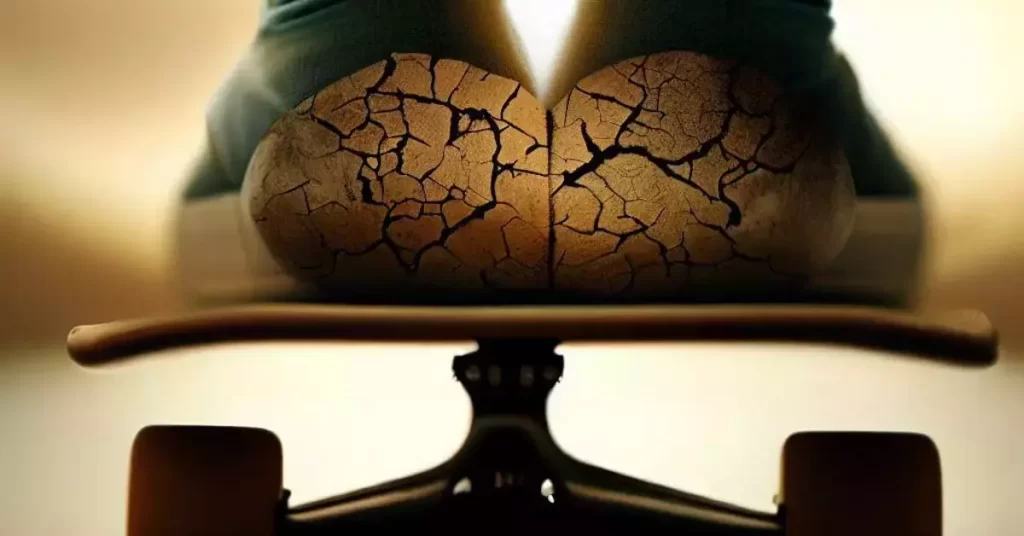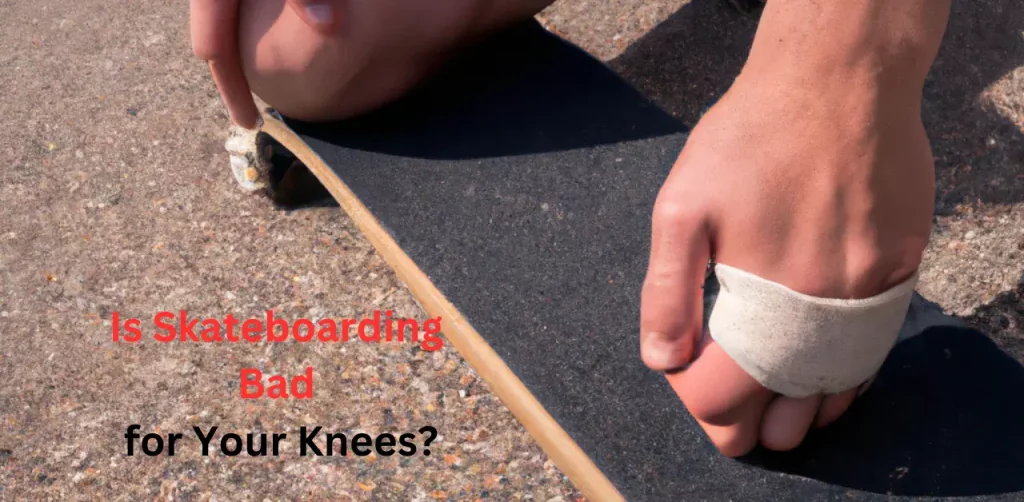Skateboard pressure cracks are small fractures or splits that occur on the surface of a skateboard deck, usually in the middle part or near the nose and tail. These cracks can range in size and severity, from hairline fractures to larger splits that extend across the width of the board.
Pressure cracks are caused by repeated stress and impact on the skateboard deck. When riders perform tricks and stunts, they put their boards under immense pressure, especially when landing hard or performing high-impact maneuvers. Over time, this constant strain can weaken the wood fibers of the deck, leading to these frustrating cracks.
Beyond their aesthetic appeal, pressure cracks also provide valuable insight into a skater’s progression and skill level. Seasoned riders often develop distinct patterns in their pressure cracks, indicating where they place most of their weight while performing specific tricks or turns. Observing these patterns can give viewers a glimpse into the unique style and finesse that sets each skater apart from the rest.
What is a skateboard pressure crack?
Skateboard pressure cracks are small fractures or splits that occur on the surface of a skateboard deck, usually in the middle part or near the nose and tail. These cracks can range in size and severity, from hairline fractures to larger splits that extend across the width of the board.
Pressure cracks are caused by repeated stress and impact on the skateboard deck. When riders perform tricks and stunts, they put their boards under immense pressure, especially when landing hard or performing high-impact maneuvers. Over time, this constant strain can weaken the wood fibers of the deck, leading to these frustrating cracks.
Cracks on a skateboard not only affect its structural integrity but also compromise ride quality and performance. They can make your board feel less stable and responsive while riding, affecting your ability to control it effectively. Moreover, if left untreated, pressure cracks may worsen over time and even lead to serious injuries if they cause sudden failure while riding.
To fix pressure cracks on your skateboard, there are a couple of effective methods you can try: using epoxy resin or wood glue. Both options involve filling in the crack to reinforce its strength and prevent further damage.
Epoxy is one of the most common choices for repairing pressure cracks due to its durability and adhesive properties. To use epoxy resin for fixing a crack:
1) Clean out any dirt or debris from inside the crack.
2) Mix the epoxy according to package instructions.
3) Apply an ample amount of epoxy into the crack using a plastic spatula.
4) Use clamps or heavy objects to hold down both sides of the cracked area until completely dry.
Why Do Pressure Cracks Occur?
Skateboards are made of wood, and when too much pressure is applied, especially around the trucks or the middle part of the board, cracks can occur. This pressure can be due to the weight of the rider, hard landings, or even just regular wear and tear. Also, performing tricks, especially landing hard on the bolts, can cause the trucks to loosen, leading to these cracks.
How to Inspect Pressure Cracks on Your Skateboard?
Regular inspection of your skateboard is essential to ensure safety. Signs of damage, like pressure cracks, may not always be apparent. Turn your skateboard upside down and inspect the area around the trucks. Look for hairline fractures or small splits. Also, inspect the nose or tail, as they can be vulnerable too. Addressing these signs early can prevent more significant damage in the future.
Epoxy or Wood Filler: Which is Better?
Both epoxy and wood filler are effective in repairing pressure cracks. However, epoxy, especially epoxy resin, offers a more durable solution. If you choose wood filler, it’s vital to let it dry completely and then apply a layer of epoxy over it for added protection.
The Role of Riser Pads in Avoiding Pressure Cracks
Riser pads, placed between the skateboard deck and trucks, can help distribute weight and reduce direct pressure on the board, thus preventing cracks. They absorb some of the shocks from hard landings and stunts, reducing the risk of pressure cracks.
Should You Repair or Replace a Cracked Skateboard Deck?
Not all cracks necessitate a new skateboard. If the cracks are minor, and mainly pressure cracks around the trucks, they can be repaired. However, if the board has significant damage in its middle part or if the cracks keep reappearing after repair, it might be time for a new skateboard deck.
Daily Care and Maintenance to Prevent Pressure Cracks
Maintaining your skateboard is crucial. Regularly inspect your board for any signs of damage. Tighten the nuts and bolts when necessary and avoid putting too much pressure on any part of the board, especially around the trucks. Remember, care and maintenance go a long way in the longevity of your skateboard.
Common Myths About Skateboard Pressure Cracks
Many believe that only old skateboards can get pressure cracks, but even new ones can crack due to improper landings or sudden force. Another myth is that small pressure cracks don’t need attention. Remember, these cracks can grow and potentially compromise the board’s safety.
The Connection Between Tricks and Pressure Cracks
Skateboarding tricks and stunts, especially those that involve a lot of force or landing on rough surfaces, can cause pressure cracks. It’s essential to learn to land tricks without putting undue stress on any single part of the board. Use techniques that distribute your weight evenly, and avoid landing on the bolts.
- Pressure cracks on a skateboard are common and are usually found around the trucks or the middle part of the board.
- Regular inspection and maintenance can prevent these cracks.
- Epoxy and wood filler are effective solutions for fixing pressure cracks.
- Riser pads can help distribute weight and reduce the risk of cracks.
- Always ensure safety and replace your skateboard deck if damage is extensive.
Whether you’re a seasoned skateboarder or just starting, understanding how to care for and repair your skateboard ensures a safer and more enjoyable ride. Keep the above points in mind, and happy skateboarding!
How to Avoid Pressure Cracks on Skateboard?
You can avoid pressure cracks in your skateboard in a few ways.
- · The best way to avoid them is to be aware of the weak spots on your board and try to avoid putting too much pressure on those areas.
- · Another good way to avoid pressure cracks is to regularly inspect your board for any damage and ensure that all the hardware is tight.
- · If you start to see a crack forming, you can try to stop it by applying some clear nail polish or super glue to the area.
- · The best way to avoid pressure cracks is to inspect your skateboard regularly and to keep it clean and dry.
- · If you see any cracks, take your skateboard to a qualified repair person or replace it.
- · Be sure to follow the manufacturer’s recommendations for the care and maintenance of your skateboard.
How to fix Pressure Cracks Skateboard
You have seen the pressure cracks on your skateboard and are wondering how to fix them. The weight of the rider on the skateboard causes pressure cracks. The rider’s weight causes the trucks to compress the deck, which in turn causes pressure cracks.
If you have pressure cracks on your skateboard, don’t worry. There are a few ways to fix them. Keep reading to learn more about how to fix the pressure cracks on your skateboard!
Use Skateboard Tool
This is the easiest way to fix a pressure crack. All you need is a simple skateboard tool that you can use to apply pressure to the crack and make it disappear. These tools are relatively inexpensive and can be found at most skate shops.
With Carbon Fiber
The best way to fix pressure cracks in a skateboard with carbon fiber may vary depending on the severity and location of the crack. However, here are some tips on how to fix pressure cracks in a skateboard with carbon fiber.
- · Use Epoxy or other strong adhesives to fill in and secure the cracks
- · Carefully sand down the area around the crack to create a smooth surface
- · Use a heat gun or other similar tool to melt the area around the crack slightly
- · Then, quickly cool it down so that the carbon fiber can better adhere to the surface.
Use Sandpaper
Typically, pressure cracks don’t run very deep into your deck. So,
- · You can sand them down using medium-grit Sandpaper
- · Then apply a fresh layer of grip tape over the area
- · This will protect your deck from getting damaged further and give you a smooth surface to ride on.
Use Epoxy
If the pressure cracks are more severe, you can repair them using Epoxy or similar adhesives.
- First, clean the area around the crack with some isopropyl alcohol.
- · Then, mix the Epoxy according to the instructions on the package.
- · Apply it over the crack and let it dry for at least 24 hours before riding your skateboard again.
Use glue
First, to fix skateboard pressure cracks using glue, clean the cracked area with a damp cloth and let it dry. Then apply a small amount of wood glue to the cracked area and use a clamp to hold the deck together while the glue dries. Once the glue is completely dry, sand the area until it is smooth and level with the rest of the deck. It’s important to note that this is a temporary fix, and replacing the damaged deck is the best solution for long-term use.
Key Takeaways
To fix pressure cracks on a skateboard, you first need to clean the affected area. Then, using epoxy or wood filler, fill the cracks. Make sure to sand the surface after allowing it to dry to achieve a smooth finish. It’s important to let the board completely dry before using it again.
- Pressure cracks on a skateboard are common and are usually found around the trucks or the middle part of the board.
- Regular inspection and maintenance can prevent these cracks.
- Epoxy and wood filler are effective solutions for fixing pressure cracks.
- Riser pads can help distribute weight and reduce the risk of cracks.
- Always ensure safety and replace your skateboard deck if damage is extensive.
Whether you’re a seasoned skateboarder or just starting, understanding how to care for and repair your skateboard ensures a safer and more enjoyable ride. Keep the above points in mind, and happy skateboarding!

“Welcome to our website, Here You’ll find a wealth of information on finding the right skating gear that will last for years to come, as well as tips and tricks to help you improve your skills. Whether you’re a beginner or an experienced skater, you’ll find something of value here.”



